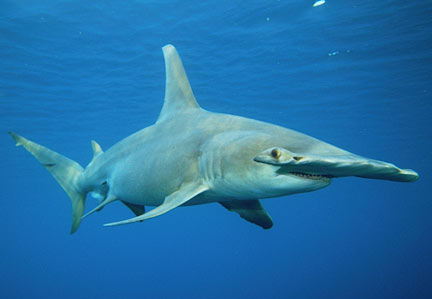
Great Hammerhead

Great Hammerhead

Great Hammerhead

The Great hammerhead shark is one of the most unique and bizarre sea predators all around the world. Its flattened head with the eyes and nostrils situated on the far sides of the head, wide mouth full of extremely sharp triangular teeth make this shark one of the most frightening animals in the water. There are several theories explaining why its head is so flattened. The first one sees the reason in stability while swimming. On the other hand the long distance between the nostrils and the eyes enable shark to find food quite easily as the sight and smell are much broader.
Its colour may vary from olive green to grey colour above and white colour below. Its length is usually 3.5 m (11.5 feet) but occasionally 6 metres long sharks were observed. Their average weight is 770 kg (1700 lb). Sphyrna mokarran is distributed in all tropical and some subtropical waters worldwide. It inhabits coastal areas of the continent, offshore islands, but can be found in the open sea as well. These sharks are solitary hunters but some schools of sharks have been reported migrating to the north or south depending on the time of the year. Their diet consists of small skates, stingrays, small sharks and also sea catfish. When measuring over 3 metres they reach sexual maturity. They are viviparous, giving birth to 20-40 young. These are born usually during summer time measuring up to 70 cm while their heads are more rounded compared to the adult sharks. This will however change as they grow.
All in all, the Great Hammerhead shark is a unique water creature which can be very dangerous to humans. It is also caught mainly because of its skin often used for leather.

Nice Pics of Great Hammerhead Sharks.
ReplyDeleteThanks
Hammerhead Shark